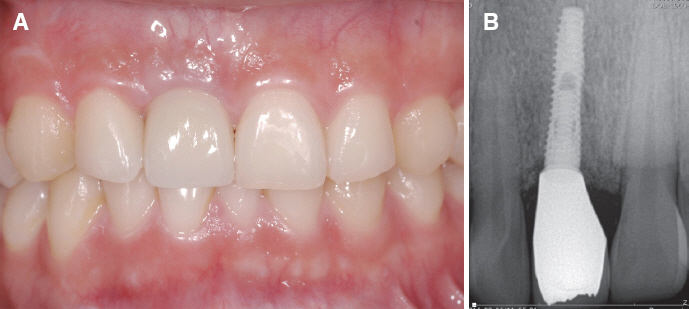J Dent Rehabil Appl Sci.
2016 Sep;32(3):240-245. 10.14368/jdras.2016.32.3.240.
A technique for fabricating abutment replica with hot melt adhesive material to minimize residual cement in implant restoration: a case report
- Affiliations
-
- 1Department of Prosthodontics and Institute of Oral Bio-Science, School of Dentistry, Chonbuk National University, Jeonju, Republic of Korea. wjdwls04@gmail.com
- KMID: 2357853
- DOI: http://doi.org/10.14368/jdras.2016.32.3.240
Abstract
- Removal of excess cement is important to prevent biological complication in cementation of implant restoration with subgingival margin. It can be difficult to completely remove excess cement. Several techniques have been introduced to minimize excess cement using abutment replica. In this case report, a simple method for making abutment replica with hot melt adhesive material in dental office was described. This technique is simple and effective because it can be used for pre-fabricated or custom abutment without additional laboratory procedure. In addition, it can minimize excess cement after cementation of implant restoration.
Keyword
Figure
Cited by 1 articles
-
Full mouth rehabilitation of fully edentulous patient with implant-supported fixed prosthesis preceding bone graft: A case report
Ju-Nam An, Jung-Jin Lee, Jae-Min Seo, Kyoung-A Kim
J Korean Acad Prosthodont. 2018;56(1):77-87. doi: 10.4047/jkap.2018.56.1.77.
Reference
-
References
1. Hebel KS, Gajjar RC. Cement-retained versus screw-retained implant restorations: achieving optimal occlusion and esthetics in implant dentistry. J Prosthet Dent. 1997; 77:28–35. DOI: 10.1016/S0022-3913(97)70203-8.2. Liang T, Hu X, Zhu L, Pan X, Zhou Y, Liu J. Comparative in vitro study of cementing techniques for implant-supported restorations. J Prosthet Dent. 2016; 116:59–66. DOI: 10.1016/j.prosdent.2016.01.014. PMID: 26946915.3. Chee WW, Duncan J, Afshar M, Moshaverinia A. Evaluation of the amount of excess cement around the margins of cement-retained dental implant restorations: the effect of the cement application method. J Prosthet Dent. 2013; 109:216–21. DOI: 10.1016/S0022-3913(13)60047-5.4. Wadhwani C, Piñeyro A. Technique for controlling the cement for an implant crown. J Prosthet Dent. 2009; 102:57–8. DOI: 10.1016/S0022-3913(09)60102-5.5. Galván G, Kois JC, Chaiyabutr Y, Kois D. Cemented implant restoration: a technique for minimizing adverse biologic consequences. J Prosthet Dent. 2015; 114:482–5. DOI: 10.1016/j.prosdent.2014.10.017. PMID: 26119018.6. Lee JH, Park IS, Sohn DS. A digital approach to fabricating an abutment replica to control cement volume in a cement-retained implant prosthesis. J Prosthet Dent. 2016; 116:25–8. DOI: 10.1016/j.prosdent.2016.01.008. PMID: 26946917.7. Rayyan MM, Makarem HA. A modified technique for preventing excess cement around implant supported restoration margins. J Prosthet Dent. 2016; Jul. 23. doi:10.1016/j.prosdent.2016.04.007. Epub ahead of print. DOI: 10.1016/j.prosdent.2016.04.007.8. Li W, Bouzidi L, Narine SS. Current research and development status and prospect of hot-melt adhesives: a review. Ind Eng Chem Res. 2008; 47:7524–32. DOI: 10.1021/ie800189b.9. Dimashkieh MR, Rayyan MR. Chairside technique for expediting indirect interim restorations. J Prosthet Dent. 2016; 115:510–1. DOI: 10.1016/j.prosdent.2015.09.025. PMID: 26723090.10. Siamos G, Winkler S, Boberick KG. Relationship between implant preload and screw loosening on implant-supported prostheses. J Oral Implantol. 2002; 28:67–73. DOI: 10.1563/1548-1336(2002)028<0067:TRBIPA>2.3.CO;2.11. Wadhwani C, Goodwin S, Chung KH. Cementing an implant crown: a novel measurement system using computational fluid dynamics approach. Clin Implant Dent Relat Res. 2016; 18:97–106. DOI: 10.1111/cid.12258. PMID: 25196982.12. Hermann JS, Buser D, Schenk RK, Schoolfield JD, Cochran DL. Biologic width around one- and twopiece titanium implants. Clin Oral Implants Res. 2001; 12:559–71. DOI: 10.1034/j.1600-0501.2001.120603.x. PMID: 11737099.13. Gapski R, Neugeboren N, Pomeranz AZ, Reissner MW. Endosseous implant failure influenced by crown cementation: a clinical case report. Int J Oral Maxillofac Implants. 2008; 23:943–6. PMID: 19014166.14. Pauletto N, Lahiffe BJ, Walton JN. Complications associated with excess cement around crowns on osseointegrated implants: a clinical report. Int J Oral Maxillofac Implants. 1999; 14:865–8. PMID: 10612925.15. Wadhwani C, Rapoport D, La Rosa S, Hess T, Kretschmar S. Radiographic detection and characteristic patterns of residual excess cement associated with cement-retained implant restorations: a clinical report. J Prosthet Dent. 2012; 107:151–7. DOI: 10.1016/S0022-3913(12)60046-8.
- Full Text Links
- Actions
-
Cited
- CITED
-
- Close
- Share
- Similar articles
-
- Management of a High-Pressure Hot-Melt Adhesive Injection Injury
- SINGLE TOOTH IMPLANT RESTORATION USING COMBINATION IMPLANT CROWN : A CASE REPORT
- Clinical case of implant restoration using customized healing abutment
- 3-D Finite element stress analysis in screw-type, cement-type, and combined-type implant fixed partial denture designs
- Implant-supported fixed prostheses with high-performance polymer (PEKK) abutments in partial edentulous patients: A case report






